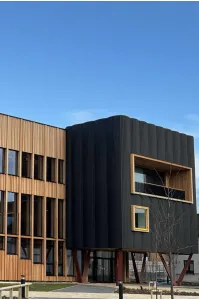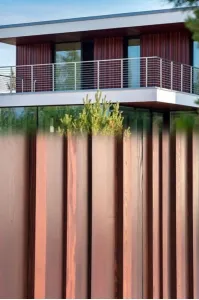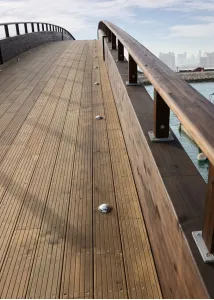
The art and science of choosing the perfect larch decking size Timber Expert
The deeper significance of deck selection: More than meets the eye.
Unraveling the timber decking size spectrum: From the norm to the novel.
For those seeking a comprehensive understanding of decking board dimensions, including insights into the intricacies of specific measurements, we invite you to delve into our thorough examination titled, "Who stole the millimeters? The mystifying world of deck board sizes and the quest for truth."
This article provides an in-depth exploration into the nuances and factors influencing the dimensions in the decking industry.
Deciding on your decking choice is a challenging endeavor that goes beyond superficial appeal. The mainstream trend in decking predominantly revolves around standard sizes. With a majority of market offerings hovering around the 140 mm width, closely followed by the 120 mm alternative, it's not surprising that these measurements dominate most decking designs. A cursory scan of social media platforms, shopping sites, or the internet at large reveals a staggering nine out of ten patios decked with boards adhering to these dimensions. Yet, this isn't to suggest that 140 mm or 120 mm are the unbeatable options! The consumer propensity for these sizes stems from a simple fact: buyers gravitate towards what's reasonably priced and readily available, while sellers naturally lean towards easier production. This creates a self-sustaining cycle where supply fosters demand, and vice versa.
Nonetheless, it's crucial to appreciate that decking selection transcends mere aesthetics, incorporating practicality, durability, user-friendliness, and crucially, your overall contentment with the outcome. The Timber Expert team comprises specialists with extensive, advanced training in the craft of woodworking. This cadre of professionals has their lives intertwined with the forest and the scientific study of wood. Their profound understanding of the medium, coupled with years of experience in the global market, guarantees an enlightened approach to decking selection, a service they proudly extend to their clientele.
In the following sections, we delve into crucial considerations that can guide you towards a more informed decking decision. We explore the key aspects of decking selection, touching on both standard and unusual dimensions. We also delve into how specific usage conditions impact your choice of decking type. Furthermore, we have an extensive "Patio decking Guide" providing a comprehensive breakdown of the different types, profiles, and combinations of patio boards available in the market.

Decoding Decking Dimensions: Width & Thickness
Selecting the right decking width: A decision guide
The conventional decking widths typically range from 90, 120, to 140 mm. However, certain scenarios may necessitate broader decking boards of 160 mm, 190 mm, and even as wide as 200 or 220 mm. Opting for wider boards does come with an increased likelihood of warping, attributable to the expanded air contact and potential exposure to external elements. Hence, when considering such expansive widths (for instance, 190 mm larch patio planks), we always recommend seeking the guidance of our expert application engineers.
Contemplating larch decking thickness: Factors to Keep in Mind
Decking thickness options span from 20, 28, 35, up to 45 mm. While a 20 mm board might appear somewhat flimsy, the inherent toughness and hardness of larch can make it suitable for specific projects. Your project's unique requirements, anticipated load-bearing needs, and usage conditions will ultimately dictate the optimal thickness and width of your decking boards. For instance, if you're contemplating using decking boards that are 160 mm, 190 mm, 200 mm, or even 220 mm wide, always consult with our experienced technicians.
Unraveling Siberian larch decking price points: Making a value-driven choice
The cost per square meter (m2) of decking board is influenced by a myriad of factors, including the quality and the physical dimensions. Importantly, these dimensions aren't confined to just thickness and width; length plays a significant role too. Being mindful of the ideal decking length for your project can translate into substantial savings. For guidance on making a length-wise decision, we recommend reading our article "How to Purchase Larch Plank without Misjudging the Length? Exploring Board Lengths from 2 to 6 meters. The 6m Larch Extra Long: Why is it Rare to Find?"
Take a look at the attached photo. Does it look familiar?
Cracks on deck boards are a common phenomenon faced by most deck owners. However, look closer and you'll notice that some decks maintain their original appearance over a long period of time, while others start to crack just a year after installation.
So why does this happen? The answer lies in a series of factors: the installation method, the materials used, the appropriateness of the deck frame design. The treatment of the board is also critical: what has been used to protect it and how it has been applied.
But there is one factor that is often overlooked, although it carries significant importance. This is the size of the deck board. Larger board sizes can amplify internal stresses in the material, increasing the risk of cracks. Conversely, smaller boards can be more resistant to this phenomenon, especially if they are properly installed and treated.
Thus, the choice of deck board size is not just an aesthetic consideration, but also a practical one. This choice can significantly impact the longevity of your deck, its usability, and ultimately, your satisfaction with the result.
Tailoring decking dimensions to operational conditions: Mastering the Sun’s Influence
In the world of decking, board dimensions, encompassing both width and length, should be carefully chosen based on specific operational conditions. It's vital to understand that different board sizes might react differently under identical environmental conditions. This concept gains particular significance in relation to sunlight exposure. Larch wood, often employed in decking boards, is not notably resistant to prolonged, direct exposure to the sun's rays. Architects globally take this factor into account when devising designs based on the property's sun exposure.
If your proposed patio will be sun-facing and subjected to unrelenting sunlight throughout the day, it becomes imperative to opt for narrower boards. In such scenarios, a 90 mm wide board tends to be the optimal choice, given its excellent stability and proven performance. Its efficacy has been demonstrated in sun-drenched coastal locales like Sochi, Yalta, and others along the Black Sea's edge. Should a 90 mm width not fit your project, you can consider boards up to 120 mm wide, but no wider. The rationale behind this limitation lies in the fact that as the board's width increases, so too does its exposure to sunlight and potential thermal deformation. Thus, these characteristics must be factored in when selecting the appropriate board size for a sun-drenched terrace.
Mitigating Warpage: Preventing Board Cracking and Bending
The thoughtful selection of board dimensions, including width and length, significantly influences your patio's longevity, its ability to maintain its aesthetics over time, and the necessity of certain upkeep and servicing measures.
Adverse factors, such as inappropriate dimensions or operational conditions, can trigger board warping, such as splits and bends at the board ends. These unfavorable processes can be averted through the careful choice of board size and operational conditions.
Primarily, one should consider the climate in which your terrace will operate. Just as vital as high-quality fixtures and proper timber treatment is a thorough understanding of the installation site's climate. Wood, being a hygroscopic material, reacts to humidity and temperature fluctuations, thus neglecting these factors may lead to premature aging of the terrace and the manifestation of deformations.
Consequently, to ensure the longevity and sustain the attractive appearance of your terrace, it's crucial to make a measured choice of decking size. This process should consider the conditions of future use, adopting a comprehensive approach to its installation and maintenance.
Striking the Right Balance: The Optimal Combination of Board Thickness and Width
How Board Thickness and Width Ratios Influence Physical and Mechanical Properties
The chosen dimensions of decking, specifically the ratio between thickness and width, directly affect its physical and mechanical properties, including its resilience to warping.
To appreciate this, it's important to understand the mechanical properties of wood as a material. Wood is anisotropic, meaning its properties change depending on the direction. Boasting a cellular structure, wood demonstrates superior strength along its fibers than across them.
If one were to consider a wide board (190 mm) with minimal thickness (28 mm), the outcome would be a board with suboptimal physical and mechanical properties. In this instance, the thickness of the board is inadequate to ensure appropriate resistance to warping.
The root of this issue lies in the characteristics of wood as a hygroscopic material. It has the ability to absorb and release moisture from the surrounding air, leading to changes in dimensions. When the width of a board significantly surpasses its thickness, it escalates the likelihood of deformations, including warping.
To mitigate this risk and guarantee proper resistance to warping, it's crucial to select a board that possesses adequate thickness relative to its width. This not only enhances the board's strength characteristics but also ensures the longevity of the terrace, allowing it to maintain its aesthetic appeal for a prolonged period.
In Summary:

Selecting the right size for a larch decking board is a critical step in any building project. The approach to this decision must be comprehensive, factoring in the physical properties of the wood and the specific conditions under which it will be used.
Maintaining appropriate proportions of board width to thickness is crucial for ensuring the board's stability and longevity. Boards that are overly wide and insufficiently thick run the risk of warping, due to unevenly distributed forces within the material.
There are both standard and non-standard board sizes, each with its distinct applications. While standard sizes work for the majority of projects, custom sizes (such as 160, 190, 200, and 220 mm wide) can be produced if necessary. However, this requires further consultation with technicians and a cautious approach to the operating conditions.
Environmental conditions and unique characteristics, like the intensity of sunlight, also influence the choice of board size. For instance, sun-soaked terraces are best suited to narrower boards.
In conclusion, the task of choosing a board size is not a simple one, but rather demands an informed and thoughtful approach. By considering all the factors outlined above, you can build a patio that not only delights with its aesthetics but also guarantees reliability for years to come.
So when you're planning to buy larch decking, don't forget about all the aspects we've discussed. For those who appreciate the beauty, durability and functionality of larch patios, we at Timber Expert are always happy to welcome you. We are ready to offer professional advice and assistance in choosing the best solution for your project.
Stepping into the World of Exports: 2023 and Beyond
In 2023, we are excited to announce that our horizon is expanding, bringing our premium larch decking to the global market. Now, we are open for exports not just to the countries of the European Union and the United Kingdom, but also to Turkey, the United Arab Emirates, and the countries of the East.
Our Budapest representative office is eager to connect with potential customers, forging lasting relationships and paving the way for a stronger future in exports. We invite you to come and interact with us, learning about our products, services, and the dedication that has defined our growth thus far.
To provide a more comprehensive insight into our export vision, we have penned an enlightening article titled "The Wood War: Europe vs. Turkey - Unveiling Price Differences in Siberian Larch Amid Sanctions and Larch-y Discounts". This article provides a deep dive into the market dynamics, pricing variances in Siberian Larch and the impact of sanctions and discounts on this valuable resource.
Our entry into the export sector is not just a business expansion, but a commitment to share the beauty and quality of our larch decking with the world. As we step into the global market, we bring with us our dedication to quality, our deep understanding of wood as a resource, and our commitment to sustainable practices.
We look forward to the journey ahead and invite you to join us as we expand our reach and continue to provide quality products to our customers worldwide. Let 2023 be the year where we unite over our shared love for quality larch decking, regardless of geographical boundaries.
Manufacturer of high-quality wood products & timber supplier
Timber Expert



